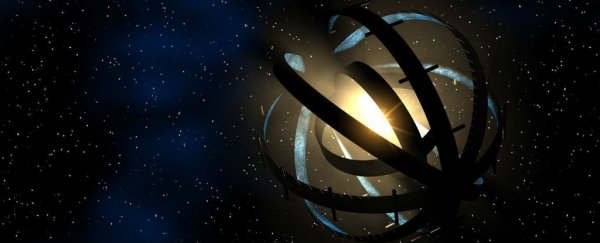Last week, astronomers made a fascinating discovery: a strange pattern of light surrounding a distant star called KIC 8462852 that cannot be explained. When a planet orbits a star, the star's brightness will usually only dip by 1 percent, but whatever is passing erratically by KIC 8462852 is causing it to dim by up to 22 percent. Something very, very big is out there, and scientists have offered up everything from a huge mass of comets to yep, even aliens, as possible explanations.
Alien megastructure or not, we just want to know, and the good news is researchers are already on the case, with the announcement that the Allen Telescope Array (ATA) - an array of 42 radio telescopes in California - has already been focussing in on the curious star, located some 1,500 light-years from Earth.
"We are looking at it with the Allen Telescope Array," Seth Shostak, a senior astronomer at the SETI (Search for Extraterrestrial Intelligence) Institute in the US told Mike Wall at Space.com. "I think we ought to, for sure," he added, but said we should prepare ourselves to be disappointed, because newsflash: it's probably not actually aliens. "[people] should perhaps moderate their enthusiasm with the lessons of history", he said.
But whatever is causing these seriously strange dips in brightness around KIC 8462852 will still make for some fascinating research, because it's defied any reasonable explanation so far. The most obvious explanation is a colossal dust cloud, but scientists have ruled this out as unlikely because space dust gives off infrared light, and no excess of infrared light has been detected around the star.
So a swarm of comets then? In this scenario, another star passed into KIC 8462852's system and the disturbance of gravity caused a huge mass of comets to be pulled in towards it before being expelled back out again. And there just so happens to be another star close enough to KIC 8462852 to make this a possibility.
But as we explained last week, we would have had to have been extraordinarily lucky to witness this specific event in cosmic history, which brings its likelihood into question too.
And, of course, the most fun explanation for that giant shadow is the beginnings of an enormous floating structure being built by an advanced alien civilisation. We can dream, right?
The Allen Telescope Array won't be looking at the brightness dips around KIC 8462852, but will instead be listening out for radio signals emanating from the vicinity, which are considered to be a good indication of international broadcasts. SETI Institute researcher Doug Vakoch told Alan Boyle at Geekwire that it's currently analysing KIC 8462852's radio signals in 9 billion channels, over wavelengths ranging from 1 to 10 GHz. "We hop along one hertz at a time … focusing on a search for narrowband signals," he said.
If the ATA picks up anything of note, the SETI researchers hope to follow up with the Very Large Array (VLA) near Socorro in New Mexico, Deborah Byrd reports for Earthsky.org. And they hopefully won't be the only ones investigating the mystery of everyone's new favourite star. The team that discovered those "crazy light curves" is right now making a pitch to have big radio dishes like the VLA or the Green Bank Telescope in West Virginia trained in on the star.
In the meantime, be sure to check out this account of the discovery by Jason Wright, the Penn State astronomer who made the original "aliens?!" comment. It's a fascinating look into what he and his colleagues have experienced so far, and gives a really interesting insight into how SETI researchers decide what to focus their attention and resources on.
As Wright says, it's probably - almost definitely - not aliens, but it's still in SETI's interest to investigate as-yet-unexplained cosmic phenomena such as this:
"One should focus one's resources on the best targets. Looking for astronomical anomalies is a reasonable way to focus one's search. There is no inconsistency between assuming purely natural explanations for all phenomena, and targeting SETI efforts at the most astrophysically inexplicable phenomena."
We can't wait to see what they find. Watch this space.
